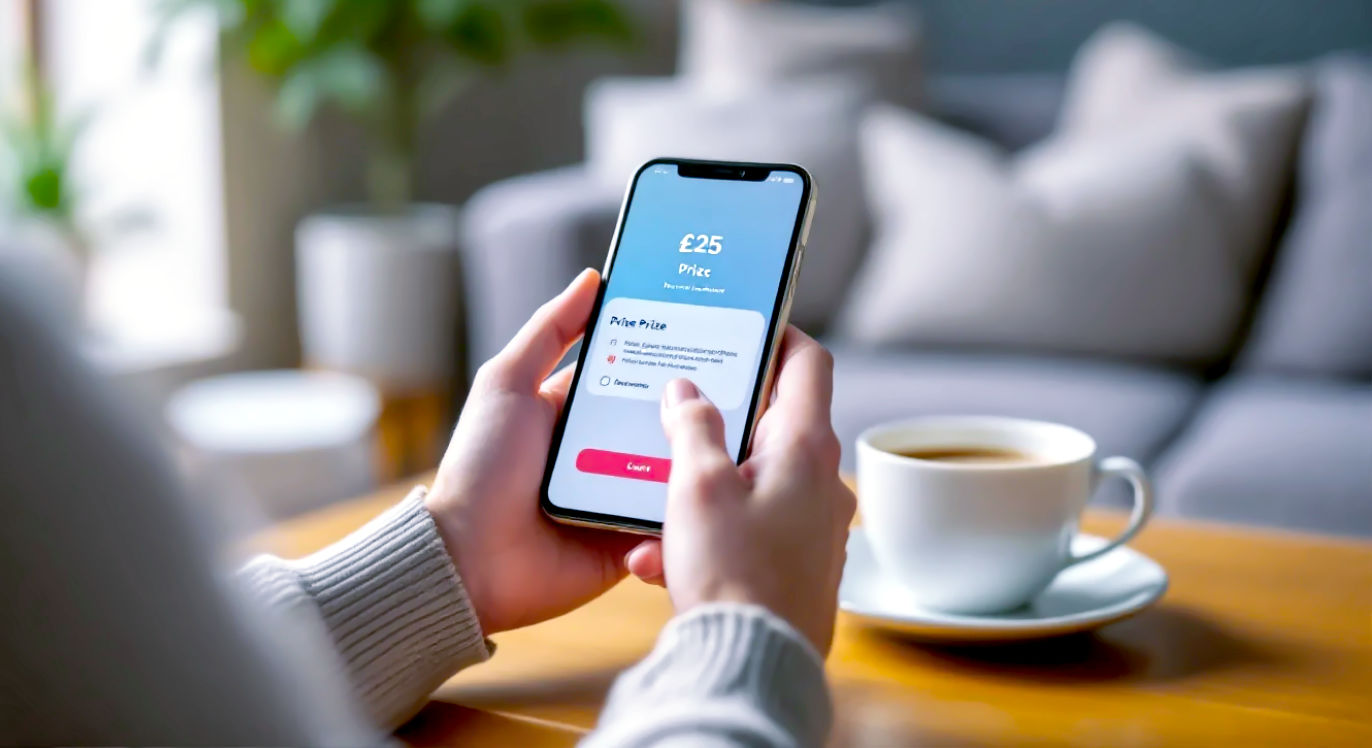Guide to NS&I Premium Bonds: The Great British Savings Gamble
The complete UK guide to NS&I Premium Bonds. We explain how they work, the real odds of winning the £1m jackpot, and if they’re a good investment for you.

This post may contain affiliate links. If you make a purchase through these links, we may earn a commission at no additional cost to you.
There’s a little ritual that plays out in millions of British homes at the start of every month. It involves a cup of tea, a hopeful heart, and a quick tap on a smartphone app or a click on a website. It’s the moment we check our Premium Bonds. For a fleeting second, we all dare to dream: have we become a millionaire overnight?
For most of us, the answer is a cheery “no prize this month.” We might win a handy £25, or even a few hundred pounds if we’re very lucky. But the dream of the big one, the life-changing jackpot, is what keeps us coming back. This unique blend of sensible saving and a lottery-like thrill is a British institution, as much a part of our national character as complaining about the weather or forming an orderly queue.
But what exactly are Premium Bonds? Are they a smart place to put your money, or just a bit of fun? How do they actually work, and what are your real chances of winning that million-pound prize?
This is your ultimate guide. We’ll unravel the whole story, from their post-war origins to the quantum computer that picks the winners. We’ll crunch the numbers, bust the myths, and give you the clear, straightforward facts you need to decide if they’re right for you. So, let’s dive in.
What Exactly Are Premium Bonds? The Basics Explained
Forget everything you think you know about savings accounts with complicated interest rates. Premium Bonds are much simpler.
Your Savings, but with a Chance to Win
Think of it like this: you’re lending your money to the government. Instead of paying you interest in the normal way, the government puts all the interest it would have paid into a giant prize pot. Then, every month, it holds a massive prize draw and gives away all that money to a lucky few bond holders.
The key things to remember are:
- Your Money is Safe: The money you put into Premium Bonds is 100% secure. You can ask for it back at any time, and you’ll always get every penny you put in.
- You Buy Bonds: Every £1 you save buys you one bond. Each bond has a unique number, and each number has an equal chance of winning in the monthly draw.
- Prizes are Tax-Free: This is the big one. Any prize you win, whether it’s £25 or £1 million, is completely tax-free. You don’t have to declare it or pay a single penny of income tax on it.
So, at its heart, a Premium Bond is a government-backed saving product that enters you into a prize draw instead of paying you interest.
Who Are NS&I? The People Behind the Bonds
Premium Bonds are run by NS&I, which stands for National Savings and Investments. You might not have heard of them, but they’re a hugely important part of the UK’s financial system.
NS&I is essentially the government’s own savings bank. It’s not a normal high street bank; it’s a part of the government, backed by His Majesty’s Treasury. This is what makes it so incredibly safe. While regular banks protect your savings up to £85,000, NS&I protects 100% of your money, no matter how much you have with them. This unique guarantee gives people enormous peace of mind.
The Grand History of Premium Bonds: A Post-War Dream
Premium Bonds haven’t been around forever. They were born from a very specific moment in British history and the vision of one clever politician.
An Idea from Harold Macmillan
Picture Britain in the mid-1950s. The country was still rebuilding after the Second World War. The government needed to borrow money to fund public services, but it also wanted to encourage people to save and control inflation. The Chancellor of the Exchequer at the time, a man named Harold Macmillan, had a brilliant idea.
He wanted to create a new type of saving that appealed to everyone. He understood that while people knew they should save, many also enjoyed a little flutter—a bet on the football pools or the horses. His idea was to combine the two. He called it a “slogan for saving,” a way to make putting money aside feel exciting.
So, on 1st November 1956, the first Premium Bonds went on sale. They were an instant hit. In the first day alone, Britons bought £5 million worth of bonds—a huge amount of money back then.
Meet ERNIE: The Machine That Picks the Winners
If you’re going to have a giant prize draw, you need a fair way to pick the winners. You can’t just pull numbers out of a hat. This is where ERNIE comes in.
ERNIE stands for Electronic Random Number Indicator Equipment. The first ERNIE was a magnificent, room-sized machine built by the same people who worked on the Colossus code-breaking computer at Bletchley Park during the war. It used the random noise generated by neon tubes to produce bond numbers, ensuring every single bond had a truly equal and random chance of being chosen.
ERNIE has been upgraded several times over the decades. Today, we’re on ERNIE 5. It no longer uses neon tubes but is powered by quantum technology, using light to generate random numbers. It’s faster, smaller, and even more random than its predecessors, capable of generating millions of winning numbers in a matter of minutes. But the principle remains the same: to make the draw utterly, unquestioningly fair.
How it All Works: From Buying Bonds to Winning Prizes
Getting started with Premium Bonds is straightforward. Here’s a simple breakdown of the whole process.
Getting Started: How to Buy Premium Bonds
You can’t just walk into a bank and buy Premium Bonds. You have to go directly to the source: NS&I. The easiest way by far is online.
- How to Buy: The main way to buy is through the NS&I website. You can make a one-off payment with your debit card or set up a regular standing order. You can also buy them by post if you prefer.
- How Much: The minimum you can invest is £25. The maximum you can hold is £50,000.
- Who Can Buy: You need to be at least 16 years old and a UK resident. You can also buy them for your children or grandchildren who are under 16.
Once you buy your bonds, they have to be held for one full calendar month before they’re eligible for the draw. For example, if you buy bonds in the middle of September, they will be entered into their first draw in November.
The Monthly Prize Draw: Your Big Chance
This is where the magic happens. The prize draw usually takes place on the first working day of the month.
- The Prize Fund: The total amount of prize money varies each month. It’s based on the annual prize fund interest rate. NS&I looks at how much money is invested in total and calculates the prize pot based on that rate. It’s important to remember this is not a rate you will earn; it just determines the size of the pot.
- The Prizes: ERNIE then gets to work picking winning bond numbers. There are always two £1 million jackpots. After that, there are prizes for £100,000, £50,000, and so on, right down to the most common prize of £25. The vast majority of winners get £25.
- How You’re Told: If you’ve registered your email with NS&I, you’ll get a message telling you to check if you’ve won. For bigger prizes (£5,000 and over), you’ll get a personal visit from ‘Agent Million’ to deliver the good news!
Checking for Prizes: Did You Win?
The easiest way to check is with the official NS&I Prize Checker app on your phone or on the website. You just need your holder’s number. You can also ask your Amazon Alexa!
The winnings are then paid out. You can choose to have them paid directly into your bank account or, if you haven’t reached the £50,000 limit, you can have them automatically reinvested to buy more bonds, increasing your chances for future draws.
A surprising number of prizes go unclaimed, often because people move house and forget to update their details. There are currently over £80 million in unclaimed prizes! You can use the NS&I website to check for any old prizes you might have missed, even from decades ago.
The Big Question: Are Premium Bonds Actually Worth It?
This is the million-dollar question (quite literally). The answer depends entirely on your financial situation, your attitude to risk, and your tax status. Let’s break down the pros and cons.
Understanding the ‘Prize Fund Rate’
NS&I sets an annual prize fund rate. As of late 2025, let’s imagine this rate is 4.00%. This does not mean you will earn 4.00% on your money. It’s an average, a measure of the total prize money being paid out.
In reality, most people will earn nothing. A few people will earn a massive return (if they win the jackpot), and some will earn a small return by picking up a few £25 prizes. The prize fund rate is just a guide to what the ‘average’ payout is across all bond holders.
The Real Odds of Winning
This is where you need a dose of reality. The odds of winning any prize with a single £1 bond are currently around 21,000 to 1 in any given month.
What does that mean in practice?
- If you have £1,000 saved, you have a good chance of winning one £25 prize per year. But you could easily go two or three years without winning anything.
- If you have the maximum £50,000, the law of averages suggests you should win several small prizes each year.
- The odds of winning the £1 million jackpot are astronomical, at over 60 billion to 1 for each £1 bond.
The key takeaway is this: Premium Bonds are not a reliable way to generate an income. You are trading a guaranteed interest payment for the very slim chance of a big win.
The Tax-Free Advantage
Here’s where Premium Bonds can be a very smart choice for some people. Because all prizes are tax-free, they are particularly attractive to higher-rate and additional-rate taxpayers.
Most people have a Personal Savings Allowance, which means they can earn up to £1,000 in savings interest per year without paying tax (£500 for higher-rate taxpayers). But if you have a lot of savings, you might end up paying 40% or 45% tax on your interest. With Premium Bonds, you don’t. A £100 prize is £100 in your pocket, whereas £100 of interest could be just £60 after tax.
Premium Bonds vs. Savings Accounts vs. ISAs
So, how do they stack up against the alternatives?
| Feature | Premium Bonds | High-Interest Savings Account | Cash ISA |
|---|---|---|---|
| Safety | Excellent (100% government-backed) | Good (Protected up to £85,000) | Good (Protected up to £85,000) |
| Returns | Unpredictable (Could be 0% or huge) | Guaranteed and predictable interest rate | Guaranteed and predictable interest rate |
| Tax | Completely tax-free | Interest is taxable above your allowance | Interest is completely tax-free |
| Access | Easy (Money in a few working days) | Can be instant or require notice | Easy, but rules on withdrawing and replacing |
Who are they good for?
- People who have already used up their annual ISA allowance.
- Higher-rate taxpayers who want to avoid paying tax on savings interest.
- People who want 100% security for their cash.
- Anyone who wants to keep a chunk of their savings somewhere safe but fancies the fun of a monthly draw.
Who should probably avoid them?
- Anyone who needs a regular, predictable income from their savings.
- Basic-rate taxpayers with modest savings, who would likely earn more in a standard high-interest account without breaching their tax-free allowance.
Practical Guide: Managing Your Premium Bonds
Once you’ve bought your bonds, managing them is simple.
Cashing In Your Bonds
If you need your money back, you can cash in some or all of your bonds at any time. There are no fees or penalties for doing so. The easiest way is to log into your account on the NS&I website and follow the instructions. The money is usually in your bank account within three working days.
Bonds for Children
Premium Bonds are a hugely popular gift for children and grandchildren. It’s a way of giving them a nest egg that they can’t spend until they’re older, with the added excitement that it might grow.
Anyone can buy bonds for a child under 16. The bonds are held in the name of the parent or guardian, who looks after them until the child’s 16th birthday. All prizes won are paid to the guardian, but the money belongs to the child. Once they turn 16, they take control of the account themselves.
What Happens When Someone Dies?
When a Premium Bond holder passes away, their bonds don’t just disappear. They remain in the prize draw for 12 months after their death. Any prizes won during that time are paid to their estate. After 12 months, the bonds are cashed in. NS&I has a simple, dedicated bereavement service to help families handle this process.
Myths, Legends, and FAQs
Because they’ve been around for so long, a few myths have sprung up around Premium Bonds. Let’s bust them.
“Do older bonds win more?”
Myth. This is probably the most common myth. The simple answer is no. ERNIE is completely random. Every single £1 bond, whether it was bought yesterday or in 1957, has the exact same chance of winning.
“Is it better to have bonds in a single block or scattered?”
Myth. It makes absolutely no difference. Whether you have £10,000 worth of bonds with consecutive numbers or in different blocks bought over many years, each £1 bond number is entered into the draw individually. Your odds are the same.
“How do I find lost or unclaimed prizes?”
If you think you or a relative might have old bonds, you can use the NS&I tracing service. You’ll need to provide as much information as you can, like names and old addresses. It’s well worth doing—you could be sitting on a small fortune!
The Future of Premium Bonds
In a world of online banking, cryptocurrencies, and instant-access savings apps, do Premium Bonds still have a place?
The answer seems to be a resounding yes. They have adapted to the digital age, with a slick app and easy online management. But their core appeal is timeless. They offer something unique that no other savings product can: absolute security combined with the thrill of possibility.
They aren’t a get-rich-quick scheme, nor are they a replacement for sensible long-term investing. But as a safe home for your emergency fund or a portion of your savings, they offer a uniquely British blend of prudence and fun. They are a national treasure, a monthly moment of hope for millions. And who knows? Next month, it might just be you.
Further Reading
For the most accurate and up-to-date information, always refer to the official sources:






